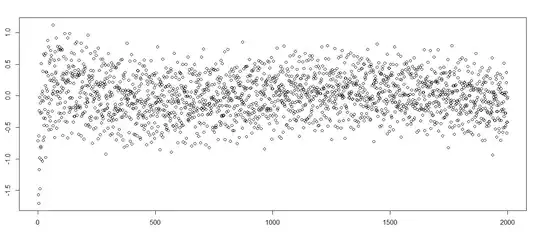Plotting the Riemann zeta zeros (the imaginary part) then it seems like they follow a pattern: Let $z_1,\cdots,z_n$ be real numbers such that $z_i < z_j$ for $i<j$ and $\zeta(z_j \cdot I + 1/2 ) = 0$. Then it seems like there exists sequences $a_k,b_k$ of real numbers such that: $$ z_j = \sum_{k=1}^\infty a_k \cdot j^{b_k}$$
I have done some analysis in R:
Let z denote the first say 2000 "zeros" of $\zeta$ in R. Let x denote the sequence 1:length(z). Then:
source("zeros.R")
x <- seq(1:length(z))
m <- nls(z ~ a1*I(x^b1)+a2*I(x^b2)+a3*I(x^b3),start=list(a3=6,b3=0.8,a1=1,b1=0.5,a2=3,b2=0.1),trace=T,control=list(maxiter=1000,minFactor=10^-5))
M <- matrix(c(m$m$predict(x),z),ncol=2,byrow=F)
print( head(M))
We get $(Z_j, z_j)$ where $Z_j$ denotes the prediction of the model:
[,1] [,2]
[1,] 14.72366 14.13473
[2,] 20.60379 21.02204
[3,] 25.39784 25.01086
[4,] 29.63939 30.42488
[5,] 33.52986 32.93506
[6,] 37.17123 37.58618
[7,] 40.62363 40.91872
[8,] 43.92607 43.32707
[9,] 47.10558 48.00515
[10,] 50.18180 49.77383
[11,] 53.16956 52.97032
[12,] 56.08039 56.44625
[13,] 58.92345 59.34704
[14,] 61.70618 60.83178
[15,] 64.43472 65.11254
[16,] 67.11422 67.07981
[17,] 69.74901 69.54640
[18,] 72.34283 72.06716
[19,] 74.89890 75.70469
[20,] 77.42003 77.14484
which is not that bad I would say. Is there any known result in this direction?
You can find the zeros.R here.
The above observation should heuristically follow from this observation which is based on data:
There exists a $K_0 \in \mathbb{N}$ such that for each $K \ge K_0$ there exist real numbers $a_{K,1}, a_{K,2},\cdots,a_{K,K},b_{K,1}, b_{K,2},\cdots,b_{K,K}$ such that for all $n \in \mathbb{N}$ we have:
$$ z_n = \epsilon_K+\sum_{k=1}^K a_{K,k} n^{b_{K,k}}$$ $$ \epsilon_K \equiv N(0,\sigma_K^2)$$ $$ \lim_{K \rightarrow \infty} \sigma_K = 0$$
Then taking the limit $K \rightarrow \infty$ we should heuristically get $\lim_{K \rightarrow \epsilon} \epsilon_K = 0$, since the expectation of $\epsilon_K$ is $=0$ and the variance of $\epsilon_K$ goes in the limit to $0$, and hence heuristically the above stated infinite sum should be true.
I have computed with the code above example values for $K=1,2,3$ using the nls function in R. It would be nice, if someone knows another package in R or Python to estimate the $a_k,b_k$ if he or she tells me of that package, since with nls I don't think one can do more than 6 parameters (K=3), or at least I haven't figured out how, if it is possible.
